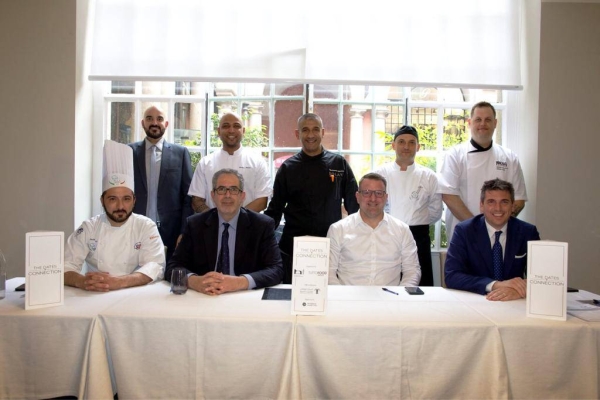
When Fatmata Binta was 11, she and her family fled the civil war in Sierra Leone and went to live in a small village in neighbouring Guinea. Hundreds of refugees descended on a place that could only really accommodate about 100. Resources, and budgets, were stretched extremely thinly.
Binta’s pastoralist Fula community prided itself on its minimalist habits: her grandmother used to chide the children when they dropped rice on the floor, telling them it would make the grains cry, “and I believed her! All of us did.” But the two years spent in Guinea tested even their resourcefulness.
“While we were in this village, everything was done from scratch,” recalls Binta. “No electricity. We had to fetch our own firewood to cook; we’d go to the stream for water; we’d garden, we’d go to the back and pick food.
“That’s when I got my respect for all of this stuff – for food and community,” she says. “Because I went through that for two years, it became part of me.”
Now 37, Binta is a trailblazing chef based in Ghana, who last week became the first African to win the Basque culinary world prize for her work showcasing nomadic food culture and exploring the diaspora of west African cuisine through her Dine on a Mat pop-up.
But the experiences of her childhood, from growing fonio – an ancient grain – on her grandparents’ land to picking cockroaches out of rice, have stayed with her. From them have sprung a desire to celebrate and support both the sustainable, low-waste culture of the Fulani people – and the women who make it possible.
“We use food as a vehicle but for me, what fulfils me the most is also impacting the lives of people, especially women. I see them; I grew up in that space, I know their challenges. When I see them, I see my mother, I see my aunties,” she says.
With the €100,000 (£86,000) prize money, she plans to build a centre where women can come to practise arts, crafts and other activities – including growing fonio – that are authentic to the Fulani people.
“We’re going to focus on … traditional methods and have a space where women can grow economically and socially,” she says. “A safe space.”
Binta has 1.5 hectares (four acres) of land in Daboya, northern Ghana, where the centre will be built.
In her cooking, Binta conjures up mostly plant-based meals with a variety of seasonal, local ingredients, “especially the underused ones”. There’s a strong focus on fonio as a versatile, resilient and quick-to-harvest carbohydrate; she has used it in breads, salads and puddings.
She also loves using moringa, baobab fruit, and dawadawa, as the Ghanaians call it: a seasoning made from the seeds of the African locust bean tree. “It has the highest umami in the world but it has a funky smell … like when cheese has gone bad,” she laughs. Many people avoid it because of this, but not Binta.
For her, the cuisine of rural west Africa is vastly preferable to that of the cities, where, she laments, the food is often overly salted and the eating culture forgotten. “People don’t slow down for food. Food is not just sustenance – food is community, it’s connection,” she says.
That belief was partly what prompted her to set up the Dine on a Mat initiative in 2018 – a nomadic pop-up restaurant that served up Fulani dishes in countries around the world. She recalls one diner, part of a group of students from Harvard Business School, telling her that she had got to know her fellow scholars better during one dinner with Binta than she had in an entire week of bus travel.
“For me, that was powerful, because I believe there’s something grounding when you sit on the floor,” she says. “It creates space for compassion and empathy. When you’re on the ground all your guards are down.”
At the core of all Binta’s work, however, is not just the food but the women who grow it, harvest it, cook it and serve it. “I really want to inspire, empower and change,” she says.
Binta’s Fulani Kitchen Foundation says it aims to empower and educate women as well as transform traditional ingredients and recipes from remote groups of Fulani “into sources of income, economic autonomy, food security and employability”.
While valuing her culture deeply, she is not blind to its flaws. “The tribe I come from, they don’t believe in education; they believe in early marriages, which is something I escaped because they wanted me to marry when I was 16 and I said no, because I’ve always been rebellious,” she says.
“There are girls who don’t have a choice, but if you can create a space for them where they can see that there’s another way, they can actually do it. You know, if I can do it, they can do it. And I think that’s how you start a good revolution.”
Fatmata Binta’s fonio jollof
Serves 6
500g fonio (or if not available, rice)
500g yellow onions
Oil
500g fresh plum tomatoes
1 abanero pepper or any spicy chilli (or to taste)
2 tsp curry powder
1 bulb garlic
1 small handful fresh thyme leaves
1-2 cups chicken or vegetable stock
1 cup mixed vegetables, finely chopped (carrots, scallions [spring onions], capsicum [peppers])
200g tomato paste
3 Bay leaves
Slice onions. Heat a frying pan and cook the onions in oil on a low heat until they caramelise. Add curry powder and let it simmer for two minutes.
Blend garlic, tomato and chilli together to a pulp. Add the pulp to the onion and curry mixture and cook on a medium-low heat until it thickens. (About 10 minutes)
Add tomato paste, bay leaf and salt to taste (you could add some allspice if you like). And cook for 10 minutes on medium-low heat. Then divide the sauce in half.
Add fonio to half of the sauce, simmer on a low heat and keep stirring for three minutes. Then add one or two cups (two if the sauce is really thick) of stock and thyme leaves and simmer for another 10 minutes. (If you cook it with rice you might need more stock and may need to cook it until the rice is soft).
Add the finely chopped mixed vegetables. Cook until vegetables are cooked through but still have a little bite. Serve the fonio with the other half of the sauce.
Top with some thinly cut scallions (spring onions) and some grilled capsicum (pepper) if you like.












